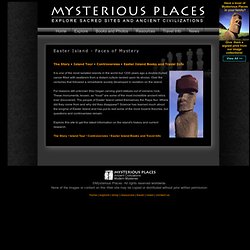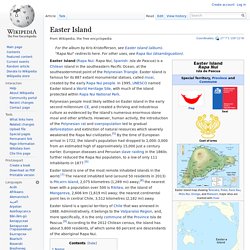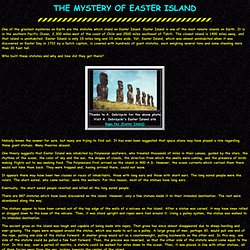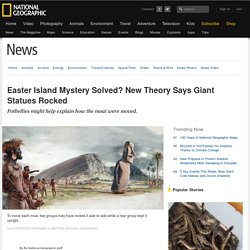

Bing. The mystery of easter island documentary bbc (50 min) par The Response Crew (hisshadyness)(Caoimhin) - Myspace Vidéo. YouTube. Science & Nature - Horizon - The Mystery of Easter Island. Primary History - World History - Easter Island Statue. YouTube. Mystery of Easter Island. Mystery of Easter Island PBS Airdate: November 7, 2012 NARRATOR: It is one of the most remote places on Earth, an island shrouded in mystery.

For centuries, people have marveled at these giant stone statues that dot the windswept terrain of Easter Island. Who carved these statues and why? How did they carve them? Now, a new experiment tests a theory for how the statues were moved… CARL LIPO (Archaeologist): Okay, ready? NARRATOR: …and attempts to find out how it was really done. SERGIO RAPU HAOA (Archaeologist): The transportation of these statues is perhaps the most important contribution of this culture to humanity. NARRATOR: Can just 26 people, using only ropes, move a 10-foot-tall, five-ton statue? CARL LIPO: I think we can do it. Easter Island: Mystery solved. The Mystery of Easter Island. Hundreds of years ago, a small group of Polynesians rowed their wooden outrigger canoes across vast stretches of open sea, navigating by the evening stars and the day's ocean swells.

When and why these people left their native land remains a mystery. But what is clear is that they made a small, uninhabited island with rolling hills and a lush carpet of palm trees their new home, eventually naming their 63 square miles of paradise Rapa Nui—now popularly known as Easter Island. On this outpost nearly 2,300 miles west of South America and 1,100 miles from the nearest island, the newcomers chiseled away at volcanic stone, carving moai, monolithic statues built to honor their ancestors. They moved the mammoth blocks of stone—on average 13 feet tall and 14 tons—to different ceremonial structures around the island, a feat that required several days and many men.
Eventually the giant palms that the Rapanui depended on dwindled. Hunt's findings caused a stir among Easter Island scientists. Mysterious Places: Explore Easter Island in words and pictures. Easter Island - Faces of Mystery The Story • Island Tour • Controversies • Easter Island Books and Travel Info It is one of the most isolated islands in the world but 1200 years ago a double-hulled canoe filled with seafarers from a distant culture landed upon its shores.

Over the centuries that followed a remarkable society developed in isolation on the island. For reasons still unknown they began carving giant statues out of volcanic rock. These monuments, known, as "moai" are some of the most incredible ancient relics ever discovered. Explore this site to get the latest information on the island's history and current research. Has-the-mystery-of-easter-island-finally-been-solved-2274075. The debate has a modern political dimension.

At stake is the central example, cited by Jared Diamond in his 2005 book Collapse: How Societies Choose to Fail or Survive, of the dire consequences that threaten if humans don't take care of the planet. The archaeological argument revolves around the moai, hundreds of stone statues that line the coast of the now treeless South Pacific island, known to its inhabitants as Rapa Nui. The almost-naked natives discovered by a Dutch expedition on Easter Sunday 1722 were considered too impoverished to have carved and moved the statues themselves.
Easter Island. Easter Island (Rapa Nui: Rapa Nui, Spanish: Isla de Pascua) is a Chilean island in the southeastern Pacific Ocean, at the southeasternmost point of the Polynesian Triangle.

The Mystery of Easter Island. One of the greatest mysteries on Earth are the statutes which stand on Easter Island.

Easter Island is one of the most remote islands on Earth. It is in the southern Pacific Ocean, 2,300 miles west of the coast of Chile and 2500 miles southeast of Tahiti. The closest island is 1400 miles away, and that island is uninhabited. Easter Island is only 15 miles long and 10 miles wide. Yet, Easter Island, which was almost uninhabited when it was discovered on Easter Day in 1722 by a Dutch captain, is covered with hundreds of giant statutes, each weighing several tons and some standing more than 30 feet tall.
Who built these statutes and why and how did they get there? Nobody knows the answer for sure, but many are trying to find out. It appears there may have been two classes or races of inhabitants, those with long ears and those with short ears. Eventually, the short eared people revolted and killed all the long eared people. There are 887 statutes which have been discovered on the island. Easter Island Mystery Solved? New Theory Says Giant Statues Rocked. For centuries, scientists have tried to solve the mystery of how the colossal stone statues of Easter Island moved.

Now there's a new theory—and it rocks. The multiton behemoths traveled up to 11 miles (18 kilometers) from the quarry where most of them were carved, without the benefit of wheels, cranes, or even large animals. Scientists have tested many ideas in the past, figuring that the islanders must have used a combination of log rollers, ropes, and wooden sledges.
Now a pair of archaeologists have come up with a new theory: Perhaps the statues, known as moai, were "engineered to move" upright in a rocking motion, using only manpower and rope.